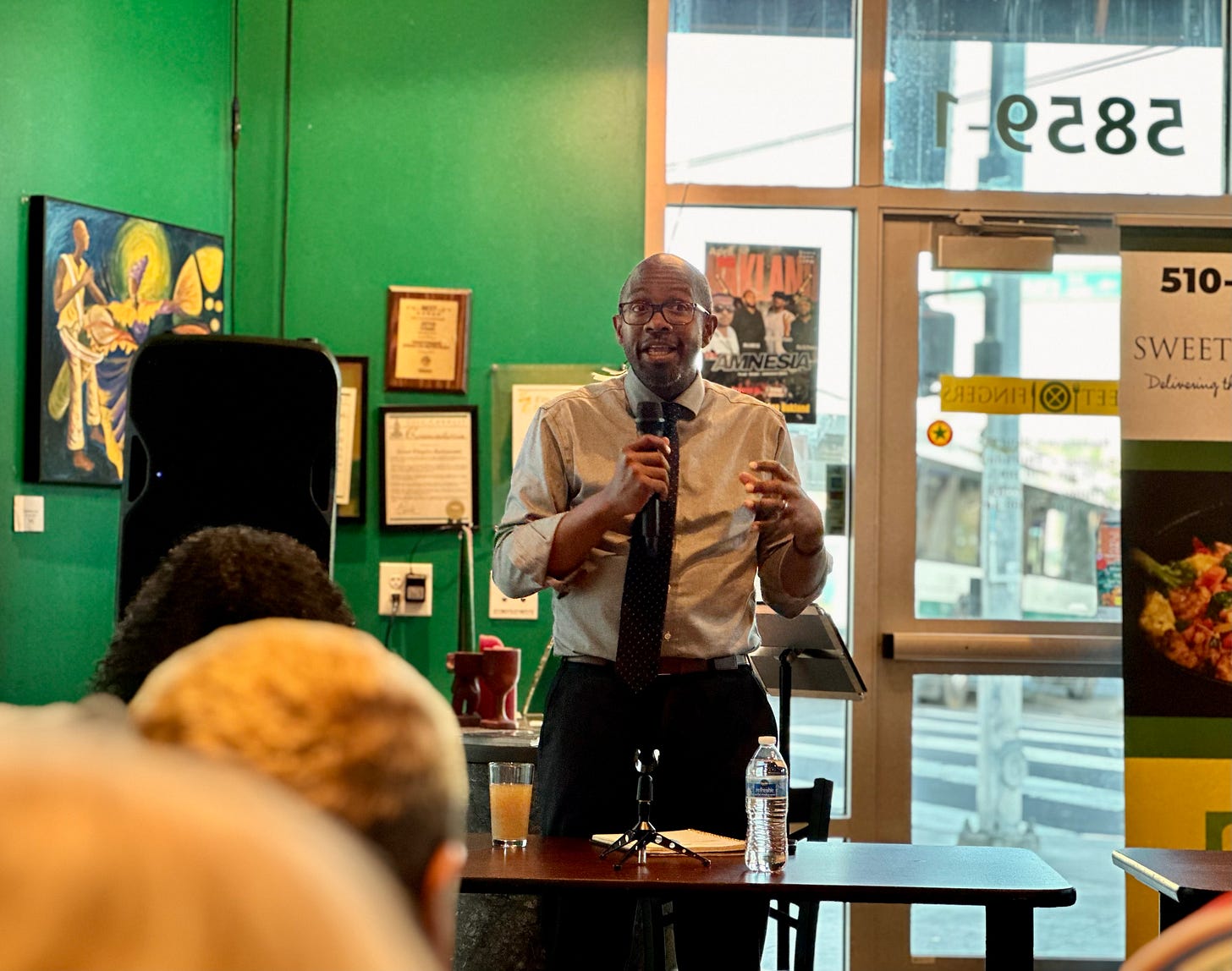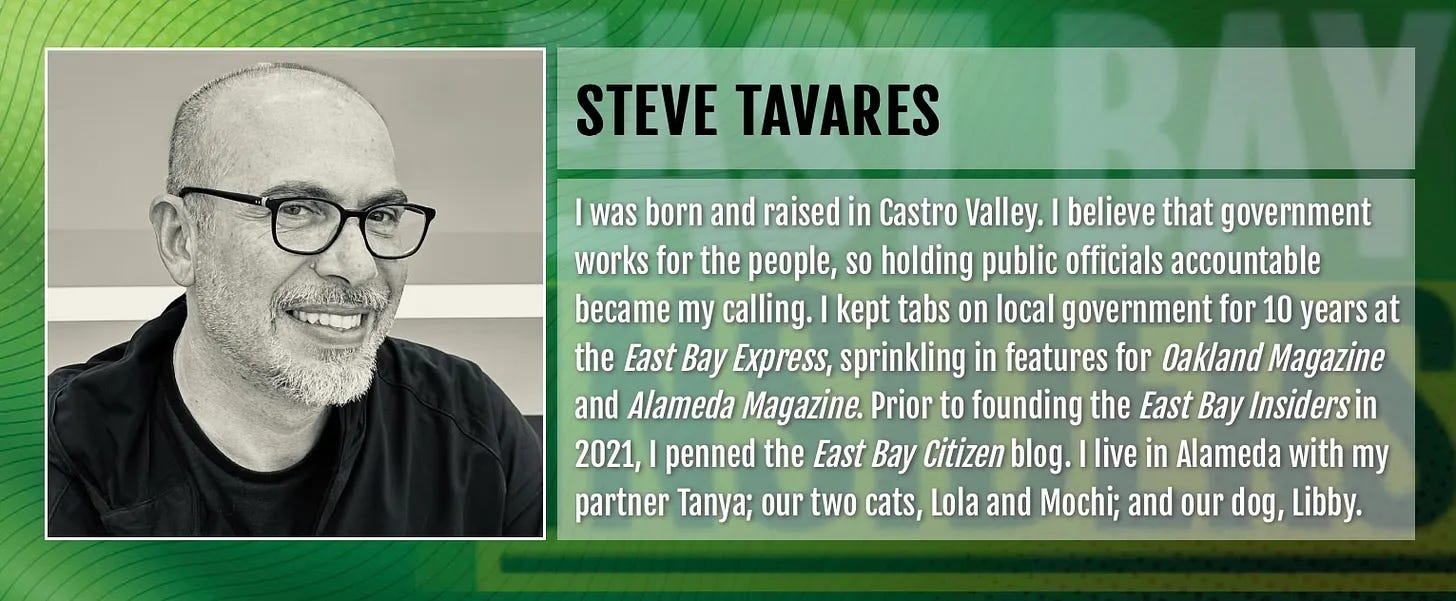Final weekend ahead
Lee offers late-arriving RCV strategy; plus storylines in Oakland's riveting special mayoral election; Pleasanton begins cuts to $10.4m shortfall; 'Dro looks at redistricting ballot measure

☕️MORNING BUZZ
—Front runners in ranked choice voting races don’t typically wait until five days from Election Day to announce partnerships with lesser candidates.
After being silent for the last three months, Oakland mayoral candidate Barbara Lee asked her supporters to rank four other candidates on their ballots.
In a video posted on social media on Thursday morning, a cheerful Lee urged her supporters to rank four other candidates below her on their vote-by-mail ballots: Renia Webb, Suz Robinson, Elizabeth Slaney, and President Cristina Grappo.
The collective strength of the quartet is debatable.
Webb’s campaign has gone noticeably silent over the past month, but she has made several appearances with Lee recently. She served as chief of staff to Sheng Thao at the beginning of her administration.
Robinson received glowing reviews in a San Francisco Chronicle endorsement. However, on the campaign trail, Robinson’s platform is more in sync with Taylor than Lee.
Slaney’s campaign has also been non-existent. Her claim to fame was her appearance at the 2018 Winter Olympics as a part of Hungary’s ski team. Slaney competed in the women’s halfpipe, despite having little experience in the event. She was called the “worst Olympian ever” by a columnist.
Grappo ran for the U.S. Senate in 2016 and received 0.8 percent of the primary vote.
—Forging coalitions with other candidates is how ranked choice voting is supposed to be strategized, but that has not happened in this special mayoral elections. Loren Taylor has not articulated a ranked choice voting strategy.
Because the field of 10 candidates is dominated by two clear front runners—Lee and Taylor—each campaign had eschewed alliances, at least, in public.
The sentiment with less than a week to Election Day is Lee and Taylor could gain a total of 90 percent of the first-place vote, leaving eight candidates to scrounge for the remaining 10 percent.
In this scenario, barring Lee or Taylor gaining a simple majority of the first-place vote, thereby sidestepping the ranked choice voting algorithm altogether, the collective slivers of second- and third-place votes could decide the election.
But, forming alliances, especially this late in the game, has typically been a move of desperation by candidates, a last-ditched effort to get back into the game.
—In the 2014 Oakland mayoral campaign, second-tier candidates Bryan Parker, Joe Tuman, and Courtney Ruby joined forces two weeks before Election Day. Back then, voters were allowed to only ranked their top three candidates.
The late effort did little to help what was an attempt to push Parker into the first-tier of candidates, along with eventual winner Libby Schaaf, Rebecca Kaplan, and Jean Quan.
Lee’s slate of candidates have almost no financial, institutional, or public support behind their candidacies.
Furthermore, the sudden embrace of ranked choice voting comes after Lee had been urging supporters to bullet vote, meaning, only vote Lee as the first-place selection and make no other choices.
OAKLAND SPECIAL ELECTION
4 days to Election Day

—DATA POINTS—Here’s the storylines as Oakland’s special mayoral race heads into the final weekend before Tuesday’s Election Day:
—Turnout: Special elections, especially those coming after a high-profile presidential election, have inherently low voter turnout. Oakland’s special election will be no different, according to a large number of consultants and insiders. The general range is anywhere between 25 percent to 35 percent turnout.
As of Wednesday night, voter turnout is 14.2 percent, according to the Alameda County Registrar of Voters office. Low turnout can play havoc with assumptions about the voting electorate at-large. Since Lee possesses almost universal name-I.D. in Oakland, lower than expected turnout is problematic for her campaign.
—Make up of the voting electorate: The general consensus is the likely Oakland voter in this special election is older and a homeowner. The scant polling seen in this mayoral race has made it clear that younger, progressive voters strongly support Lee. This group, however, is notorious for not matching their exuberance with actually casting a ballot. Conversely, the polls show older voters strongly support Loren Taylor. A good chunk of this demographic are homeowners.
The number of voters in the highlands are turning in their ballots in higher proportions than those in the flatlands, according voter data compiled by the registrar’s office. That’s a very positive development for Taylor. However, older and less-progressive voters tend to send in their ballots early.
—Labor’s pocketbook: Lee’s campaign is reaching out to labor unions not necessarily connected to Oakland and the region. That’s a desperate sign that Lee supporters have sent an “all hands of deck” message to labor across the region. But it’s also a boon for Lee’s campaign and independent expenditure committees (IEs) that support her. Labor appears to have a bottomless pit of cash to spend on this race. The fact that so much is coming in late after an initial large investment from SEIU Local 1021, IFPTE Local 21, and the California Nurses Association is clearly a sign of a tightening race.
Just yesterday, Supporters of Barbara Lee for Oakland Mayor, the main IE supporting her campaign, received a total of $17,500 in contributions from Amalgamated Transit Union Local 1555 PAC ($10,000) American Federation of State, County & Municipal Employees-Council 57 PAC ($7,500). On Wednesday, the IE received a total of $37,500 in contributions from labor unions.
—Ground game: Races, especially competitive ones, are won on the ground. This is where should Lee hold an advantage over Taylor. Strong union support is not only about a seemingly endless supply of cash. More importantly, it’s about union foot soldiers, painstakingly canvassing neighborhoods, and Lee should benefit from the voter outreach and get-out-the-vote efforts.
There are signs that Taylor’s campaign is also blanketing certain areas of Oakland. Additionally, an IE supporting Taylor’s campaign reported last week spending more than $80,000 on canvassers. The outlay could possibly match labor’s ground game.
CITY NEWS
PLEASANTON
—MORE BUDGET CUTS TO COME—Pleasanton plans to balance its $10.4 million budget deficit for Fiscal Year 2025-26 by reducing library hours, school crossing guards, and eliminating one school resource officer, among a large menu of potential cuts discussed by the city council on Thursday evening.
—Pleasanton’s two-year budget estimates a $12 million shortfall in Fiscal Year 2026-27. City staff plans to return with a proposed draft budget in late May.
—But the council sidestepped approving budget cuts to landscaping services, while retaining two school resource officers, and preserving one special enforcement unit police officer position.
—Last month, the Pleasanton City Council directed staff to begin reducing the $10.4 million shortfall by reallocating $2 million from its pension trust.
—More budget cuts are on the horizon. Thursday night’s action sliced off $6.2 million from the upcoming fiscal year budget, but short of the $8.8 million needed to balance the budget. Meanwhile, only $6.6 million was cut from the $12 million shortfall expected in Fiscal Year 2026-27.
—Pleasanton Mayor Jack Balch proposed reduced funding for its Capital Improvement Project fund, and pension and benefits costs in order to lessen the amount of cuts to city services.
—The proposal was roundly rejected by Councilmembers Julie Testa and Jeff Nibert, who called it a “short-term solution and in the long-term will come back to haunt the future councils, as well as the city, and all of its residents.”
—The need for steep cuts to services comes after Pleasanton voters refused to pass Measure PP last fall, a half-cent sales increase.
—“We’re in the position that we are in today, because we did not pass a very small tax measure that would have prevented the chaos that we are in now,” said Testa, who supported Measure PP.
—Nibert, who also supported the sales tax measure, said, “Almost 19,000 voters told the city to live within its current level of resources. They told us clearly that they wanted drastic cuts.”
—The latest rounds of budget cuts will not be the last, Nibert warned, unless voters pass a tax measure or infrastructure bond in the near future.
—“We haven’t gotten to where we needed to be yet,” Nibert added, “and we have not even mentioned yet the scenario should a recession occur.”
—RECESSION WORRIES—“It’s a challenging time for everyone,” Pleasanton City Manager Gerry Beaudin said on Thursday night.
—It very well could get more challenging in Pleasanton if increasing concerns about a recession spurred on by the Trump administration’s policies come to fruition.
—Pleasanton’s economic outlook posits an average annual shortfall of about $13 million.
—In a scenario in which there is a market downturn—not even a recession—the annual average estimate increases to $22 million, Beaudin said.
—“The entire list of reductions that we have put forward at this time does not achieve the $22 million number,” he added.
—Although, President Trump placed worldwide tariffs on hold for 90 days, the move failed to quell the market’s volatility. City staff will continue to monitor the city’s expenses and revenues in coming months, Beaudin said.
SAN LEANDRO
—MOST BEAUTIFUL WORD—Uncertainty about tariffs is already hitting local government.
—In San Leandro, a plan by the library to purchase “privacy pods,” indoor structures that foster a quiet studying environment for up to four people, could become more costly because of the Trump administration’s high tariffs.
—The “privacy pods” costs $269,000, but San Leandro Library officials asked the city council on Monday to approve a $25,000 contingency fund, in part, to cover any extra costs tacked on to its cost by increased tariffs. The contingency fund would also cover potential costs for installation of the structures.
—REDISTRICTING BALLOT MEASURE—Council redistricting is on the horizon in San Leandro after the city received a letter asserting the city’s current system of electing councilmembers violates the state’s Voting Rights Act.
—San Leandro will begin the public outreach process and creation of redistricting maps later this month.
—Rather than approving redistricting through the legislative process, as a large number of nearby cities have done in the past, San Leandro officials appears intent on placing the issue before voters in June 2026.
—But the move raises some questions. If San Leandro’s unique hybrid system of district and at-large elections is acknowledged by the city as violating the Voting Rights Act, what happens if residents vote down the redistricting measure next year? Essentially leaving intact an illegal section of its City Charter.
—JUAN FOR THE STATUS QUO—In San Leandro, a council candidate must live in one of six districts, but each candidate runs citywide. The impetus for the often ridiculed system was to break the dominance of candidates hailing from the San Leandro hills.
—Over the past decade, San Leandro has struggled mightily to field candidates willing to run for the city council and school board. Some point to the high cost of running a citywide campaign. Conversely, a district-based system would greatly decrease costs.
—San Leandro Mayor Juan Gonzalez III said the Voting Rights Act threat against the city lacks evidence. “I don't see a problem on my council,” Gonzalez said. “I don’t see it dominated by one gender. In particular, one sexual orientation, one particular racial group, one particular ethnicity.”
—The current election system provides balance, he said, by ensuring some districts are not allowed to form alliances that disadvantage other parts of the city.
OAKLAND
—DISMISSAL—The Oakland school board dismissed long-time Superintendent Kyla Johnson Trammell on Wednesday, joining Hayward, which sacked its superintendent in February. The school districts have much in common.
—Both are facing large budget shortfalls. Additionally, both are under oversight by the Alameda County Board of Education, and faced possible receivership by the state due to their budget woes.
—Oakland could run out of cash in the fall without fiscal belt-tightening. Until Hayward boardmembers begrudgingly approval budget cuts last month, the school district was facing the prospect of not being able to meet payroll by sometime in May.
CAMPAIGN FINANCE
OAKLAND
—💰MONEYBALL—Form 497 large campaign contributions filed on April 10:
SPECIAL MAYORAL ELECTION
—Supporters of Barbara Lee for Oakland Mayor 2025, Committee to Expand the Middle Class Candidate Committee, Sponsored by Airbnb, Inc., $25,000; Amalgamated Transit Union Local 1555 PAC, $10,000; American Federation of State, County & Municipal Employees-Council 57 PAC, $7,500. TOTAL: $42,500.
—🧾EXPENDITURES—Form 496 Independent Expenditure Reports filed on April 10:
SPECIAL MAYORAL ELECTION
—Barbara Lee, Citizens For A Brighter Oakland Future - Barbara Lee for Mayor 2025. 👍SUPPORT (Consulting—$3,000; Graphic design—$200). TOTAL: $3,200. (Cumulative total spent: $67,701.)
SPECIAL DISTRICT 2 COUNCIL ELECTION
—Charlene Wang, Empower Oakland Committee. 👍SUPPORT (Mailer production/delivery—$9,703; Consulting—$833; Graphic design—$800; Voter data—$401). TOTAL: $11,737. (Cumulative total spent: $81,041.)
—Kara Murray Badal, California Working Families Party. 👍SUPPORT (Digital ads—$500). TOTAL: $500.









